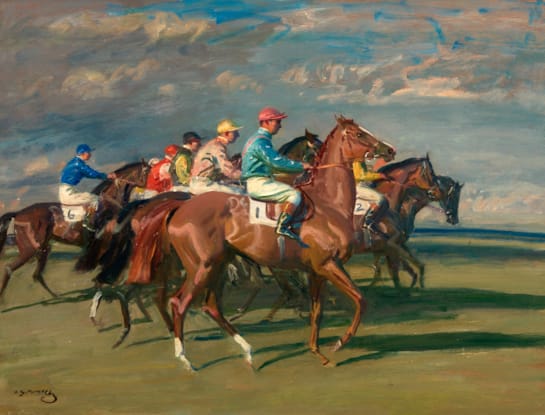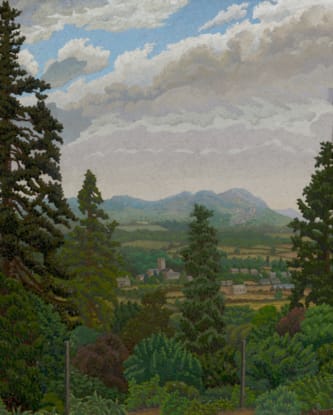Duncan Grant
(1885 - 1978)
Still life with fruit and a jug
Signed and dated, lower right: D.Grant/-/60
Oil on paper laid on board
15 x 31¼ in – 38.2 x 79.2 cm
Frame size
21 x 37 in – 53.3 x 94 cm
Oil on paper laid on board
15 x 31¼ in – 38.2 x 79.2 cm
Frame size
21 x 37 in – 53.3 x 94 cm
Tel.: +44 (0)20 7839 7693
Provenance
The artist, circa 1965;
Private collection;
Their sale, Christie’s, London, 2 March 1979, lot 97;
The Belgrave Gallery, London;
Private collection, UK
Private collection;
Their sale, Christie’s, London, 2 March 1979, lot 97;
The Belgrave Gallery, London;
Private collection, UK
Biography
Duncan Grant in his heyday was considered to be one of the most important British artists of his time, and a significant figure in the Bloomsbury Group. Grant was born 21st January 1885 to Ethel McNeil and Bartle Grant, a Major in the army who served for much of his career in India and Burma where Grant spent his early years. Grant’s grandfather was Sir John Grant 12th Laird of Rothiemurchus and it was in Aviemore Inverness-Shire that he was born before the family travelled to India.
Grant returned in 1893 to be educated in England, first at school in the Midlands and then at St. Paul’s London. Although expected to emulate his father and join the army, encouraged in his enthusiasm for art by his aunt, Lady Strachey and the French artist Simon Bussy (1870-1954) Grant enrolled at the Westminster School of Art. He travelled to Italy the same year studying Masaccio, amongst others.
In 1906 Grant moved to Paris enrolling at Jacque Emile Blanche’s (1861-1942) Art School ‘La Palette’ with an introduction from Simon Bussy. He lived in a large apartment with fellow students and formed friendships with Wyndham Lewis (1882-1957), Augustus John, OM, RA (1878-1961) and Henry Lamb, MC, RA (1883-1960). On his return to London in 1907 he studied for a term at The Slade before setting up in a studio in Fitzroy Square.
Grant continued to visit Paris, visiting Pablo Picasso’s (1881-1973) studio and met Henri Matisse (1869-1954) in 1909 again through Simon Bussy and was significantly influenced by the work of the Fauve artists and Paul Cézanne (1839-1906) seen in the first Post-Impressionist Exhibition of 1910-11; Grant exhibiting in the second such exhibition in 1912.
Roger Fry (1866-1934) the artist and critic was a further influence and on Fry’s founding of the Omega Workshop in 1913 Duncan Grant was appointed co-director along with Vanessa Bell who was having an affair with Fry at this period.
Grant knew Vanessa Bell and her husband Clive, they had visited him in Paris, but although gay, he moved in with Vanessa and her two children. In 1916, a conscientious objector he and his lover David Garnett moved to Charleston near Firle in East Sussex where Clive Bell and his mistress were often visitors. In 1918 Grant and Vanessa Bell’s daughter was born.
Grant and Vanessa Bell were central figures in the Bloomsbury Group, along with Roger Fry, Clive Bell, Virginia and Leonard Woolf and Grant’s cousin Lytton Strachey and John Maynard Keynes; Bloomsbury and the Omega Workshop were concerned not only with painting but design, furniture, pottery and textiles.
In 1935 Grant was one of a number of artists commissioned to supply paintings and textiles for furnishing the HMS Queen Mary, none of which were finally accepted.
Grant had a long and distinguished career; he exhibited at the NEAC from 1909, at the Friday Club, founded by Virginia Woolf from 1910 and became a member of the Camden Town Group in 1911. The same year Grant exhibited with Wyndham Lewis in the Grafton Group and in 1912 in the second Post-Impressionist Exhibition.
In 1914 Grant was included in ‘The Twentieth Century Art Show’ at the Whitechapel Art Gallery. Following the war, during which he was a Conscientious Objector, he was elected a member of The London Group in 1919, and in 1920 held his first one man show at the Carfax Gallery. Thereafter Grant exhibited regularly until 1977 showing at the Venice Biennale in 1926 and 1932. In 1959 a Retrospective was held at the Tate followed by an Arts Council Tour and in 1975, in honour of his 90th birthday, exhibitions were held at the Tate and Scottish National Gallery of Modern Art.
A highly important figure in twentieth century British art, the Bloomsbury Group was a significant and influential movement, Grant lived with Vanessa Bell and their daughter until she died in 1961. Paul Roche (1916-2007) a poet looked after Grant subsequently, securing Charleston for the remainder of Grant’s life and was co-heir to his estate. Grant died 8th May 1978.




